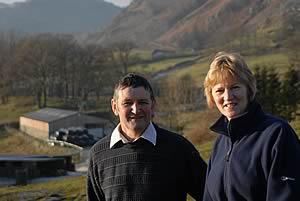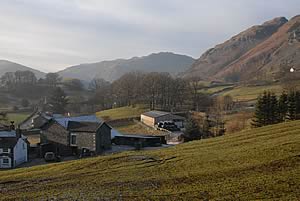04/04/08
Building a new cattle shed has helped ensure the future viability
of a beef and sheep farm in the heart of the Lake District.
John and Maureen Birkett with their new shed
 |
John Birkett’s family has farmed in the Lake District for
generations and now he and his wife Maureen farm two holdings under
numerous constraints at Little Langdale in the beautiful Langdale
Valley near Ambleside.
They have a herd of 30 registered Limousin cows at the owner-occupied
65-acre Wilson Place as well as running a total of 1,200 sheep,
mostly Herdwicks between Wilson Place and Birk Howe, which is tenanted
from the National Trust.
The running of Birk Howe was taken over from John’s father
George in 2000 and the Farm Business Tenancy stipulates that the
farm’s 240 acres carry no more than 10 cattle alongside the
Trust’s flock of 535 Herdwick ewes – and no cattle
from the end of October to the end of May.
Until 2005, all the cows and calves were housed in traditional
stone buildings at Wilson Place.
“We had invested money in the farmhouse at Wilson place where
Maureen ran a bed and breakfast business for 25 years and when
we got Birk Howe we knew we could keep more cattle in order to
get more money from farming,” said John, who runs the farm
with weekend help from son Andrew, who is keen to farm and who
works for a neighbour. Daughter Julie is a compliance planner for
the national park.
“We had been thinking about a new building but we were always
so much short of the money to pay for it.
“I read about Farming Connect Cumbria and I decided to apply
for planning permission early in 2004 before I made a grant application.
“Without the new building we would have either had to reduce
cow numbers or get rid of them altogether and we would not have
been able to increase our sheep numbers to compensate because we
are in the ESA. We wouldn’t want to give up farming.”
The Farming Connect Cumbria programme, managed by Harry Martin
and run under the umbrella of Cumbria Rural Enterprise Agency,
draws to a close this year after injecting almost £7.5 million
of capital as well as technical advisory work into the county’s
farms since its inception just over three years ago.
The Birketts were successful in getting the maximum grant for the
basic building and work started in June 2005 with Alan Mason, of
Caton, completing the build in time for winter housing that year.
Birk Howe
 |
To comply with planning requirements of the Lake District National
Park – as well as the farm being in a European Special Area
of Conservation – the 100ft by 40ft building had to have
stone-faced walls to blend with the farm’s existing buildings,
as well as Yorkshire boarding and a specific roof colour.
The building, which is open sided to the north at the feed barrier,
has a 12ft feeding passage with the remaining area able to be divided
into up to five pens, giving flexibility for a calf creep area
and for segregating and handling cattle.
It is situated away from a beck, which runs through the farm, and
prior to the building being erected an environmental assessment
of the farm was carried out.
A novel suggestion made by the Farming Connect Cumbria grant panel
was a rainwater collection system, which, although it was not grant-aided,
the Birketts installed, and its three-year pay-back is almost up.
With rainfall being in plentiful supply – some years it is
as much as 120 inches – and water costing more than £1.20
a cubic metre the 7,000 litre water tank has almost paid for itself
over the three winters.
The cattle housing is fed water from the mains and the tank and
when it is full it supplies four days of drinking water for the
cattle.
As well as the two farms at Little Langdale, the Birketts have
fell rights on Little Langdale common and two other lots of rented
land at Brantwood and Coniston which total 115 acres.
“We’re working in a system that we can’t change.
We have been farming in the Lake District ESA since it started
in 1993 and at Wilson Place we have 20 acres of herb-rich meadows
which are SSSIs that can only be spread with farm yard manure.
“It takes about a third of the time to feed and bed the cattle
compared with in the old buildings. We run a simple system, feeding
the cows big bale silage which is rolled out along the feed barrier,” said
John.
Freeing-up his time has meant he can go back to dry stone walling
work which he did before taking on the tenancy of Birk Howe, which
helps to supplement the farm income. It also gives more time to
look after the sheep.
As well as the building giving excellent ventilation – there
have been no cases of pneumonia in the calves and providing better
welfare, the versatile pen area makes handling simple.
“We are in a two-year parish for TB and we had a reactor
which meant we had to test all the cattle three times in six months.
We can set the gates up to get the cattle moving around the building
from the crush. Our vet is happy – he says it works.”
“It’s a lot safer and easier and now the cattle know
they can’t escape they are a lot quieter being handled this
way.”
Another benefit to improved cattle welfare is that they are thriving
better in their new environment.
Calves are sold at eight to 12 months old as bulls or any heifers
not retained as replacements and recent prices have highlighted
the improved conditions selling consistently at prices around £600
to £800 through Penrith market.
Easy access to the building means that it can be mucked out by
machine instead of with a fork by hand as in the old buildings.
Manure can be left in the building all winter and used to better
advantage when it is required for spreading, particularly after
making silage, saving on fertiliser costs.
When it is cleaned out in the summer months it can provide temporary
cover for straw which has been delivered to the farm. It even provided
stabling for the Clydesdale horses when they came through Cumbria
to their new home from Scotland!
 New Sheep Housing Provides Ideal Environment New Sheep Housing Provides Ideal Environment
 Bright Future for British Blondes Bright Future for British Blondes
 Lakeland Brand Helps Beef Up Prices Lakeland Brand Helps Beef Up Prices
|




